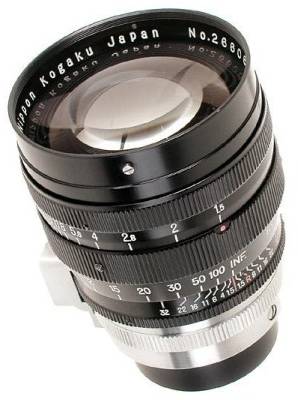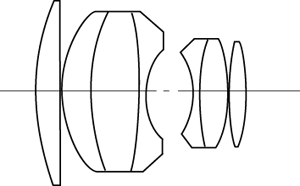
Canon Serenar 1:1.5 f=85mm (1952) .. das 139. der recht kleinen ersten Serie....

 |
 |
|
 |
 |

|
| The Pioneer: LEITZ Summarex (1943)
- the first Gaussian fast telephoto. Extremly spreaded curves - I
cannot imagine the performance of this lens is very good. Very heavy -
more than 700g. See Erwin
Puts about LEICA telephotos and evolution (big pdf- file) |
Japenese Successor No. 1: The
CANON fast telephoto - 1952, this is the second, black-chrome
series - kind of a Sonnar but with the last cemented triplet splitted
in two. Big second group, but diagram looks more harmonically than
outer design. Could be front-heavy (730g). Less expensive than the
other - typically vintage CANON - but I would guess at least equal in
performance. See Canon
Museum for more technical data. All of them above take 58mm filters - compared to the 48mm of a Nikkor-PC 2/85.. hm hm... if they are really f/1.5 lenses..?? |
Here comes No. 2: Nikkor S.C.
1.5/ 8.5cm - 1953; one of the first (if not the first) black
enameled lenses - In my oppinion, the nicest of them all. 533g -
in the range
of the Nikkor-P.C. 2.5/105. The Nikkor is a pure Sonnar type -
therefore compact - diagram looks like the ZEISS 2.0/ 8.5cm. Unfortunately ZEISS never did a fast telephoto at that era - it took them 25 years to come along! The complete story of this lens at http://www.nikon.co.jp/main/eng/portfolio/about/ history/nikkor/n19_e.htm |


 1.8/85 open aperture: bokeh calmer, but cooler colors than with the f/1.5, similar light-falloff to the corners |
 1.8/85 bei f/4: well balanced, clearly cooler color saturation the with the f/1.5 |
 1.5/85 @ f/1.5 |
 1.5/85 @ f/4 |
 1.8/85 @ f/1.8 |
 1.8/85 @ f/4 |

 Biotar 1.5/ 7.5cm f. Exakta (ohne T; S/N 2688175) Serie 1 (Kriegsproduktion)
Ca. 1947, mit T-Vergütung. Ab 1950 Brennweitenangabe von cm auf mm umgestellt |
 Biotar 1.5 / 7.5cm Serie II - die schönste Form - ab ca. 1947 mit T-Vergütung. Photo Kensetsu-San  Ein sehr schönes Biotar Serie III - gebaut ab 1953 - Photo von J.Andrzej Wrotniak (Exakta Website)  Biotar
1.5/75mm (Ser. III) in M42
mount (Photo Cameraquest) Biotar
1.5/75mm (Ser. III) in M42
mount (Photo Cameraquest) |
